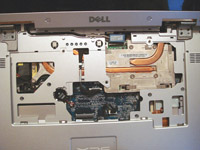Dell XPS M1710 Version 2.0
Internals

Without question, the latest incarnation of Dell's flagship XPS M1710 notebook looks identical to the company's initial offering. However, in this particular case (both literally and figuratively) it's what is lurking beneath the system's clean and polished surface which makes it unique. Armed with a handful of screwdrivers and a will to see the latest mobile technology with our own two eyes, we began to disassemble the system.
After popping-off the casing over the LCD hinges using a flathead screwdriver, we simply remove two Phillips screws and unlock a ribbon cable to allow us to remove the keyboard. Here, we get our first glimpse at both the CPU and GPU which are both hiding under very sizeable heatsink assemblies. In the case of the CPU, there is a single heatpipe running to a solitary copper radiator. In contrast, the flagship NVIDIA GeForce Go 7950 GTX relies upon two heatpipes and a dual copper radiator configuration to keep temperatures under control.
Unfortunately, being able to see these components at this stage is nothing more than a tease. In order to gain total access to the CPU and GPU and be able to remove the heatsink assemblies, there is an endless array of screws which must be removed from both the top and bottom of the lower assembly. After removing upwards of fifteen screws, the black bottom of the system can be removed from the silver keyboard casing and the true internals be fully exposed. Despite being a fairly long and painful process, this is certainly something only a small percentage of inquisitive enthusiasts will have to endure.
The first fruits of our mechanical efforts are easily the most critical new aspect of the latest version of the XPS notebook. Here, we have the flagship 512MB NVIDIA GeForce Go 7950 GTX which is designed around an MXM3 HE form factor. Looking closely at the GPU core, we see it is marked as a "GF-GO7950-GTXHN-A2". Although NVIDIA refused to comment on the details of their internal GPU marking, we would suggest that this nomenclature is to specify a particular "premium bin" of this GPU which are guaranteed to work at a particular frequency. Somewhat ironically, it is odd that the GPU "could" be binned as Dell has opted to run with the lowest 600MHz memory frequency option and not the highest 700MHz frequency the GeForce Go 7950 GTX was also supporting per the launch information.
The next piece of hardware we uncovered would be the Intel Core 2 Duo T7600G processor. What is extremely interesting and unique about this product is that Intel has released it with all the necessary feature for overclocking. In addition to unlocked multipliers, the CPU also features a 2.33GHz operating frequency, 4MB cache, and a 667MHz FSB. Slightly closer to the center of the motherboard, we find the Intel 945GM chipset. Seemingly a testament to a cooler operating temperature, the chipset is able to share the same copper heatpipe and radiator as the processor without having any adverse effect upon stability or system temperatures.
Luckily, accessing the components which reside on the below the motherboard is infinitely easier to access. Removing two screws allows us to open a small lid which covers the system's two SO-DIMM slots. The test system we received was shipped with two 1GB Samsung M470T2953CZ3-CE6 memory modules which are rated to run at 667MHz.
Another improvement over the previous generation XPS M1710 can be found by accessing the system's wireless bay. Again, two screws allow us to remove a lid which houses the discrete modem and wireless NIC. Unlike the Intel 3945 wireless NIC which supports 802.11a/b/g, the latest XPS M1710 uses the new Dell Wireless 1500 dual-band wireless card. Supporting a draft of the new 802.11n standard, this wireless card can support a theoretical data rate up to 270Mbps which is a healthy upgrade from 802.11g's 54Mbps, at least on paper. Looking at the wireless module itself, it is surprising to see how small the device actually is. The entire module easily fits in the palm of even the smallest hand. Putting our surprise at the size of the device at bay, we discover that Dell is utilizing a Broadcom PHY to power their latest wireless module.

















